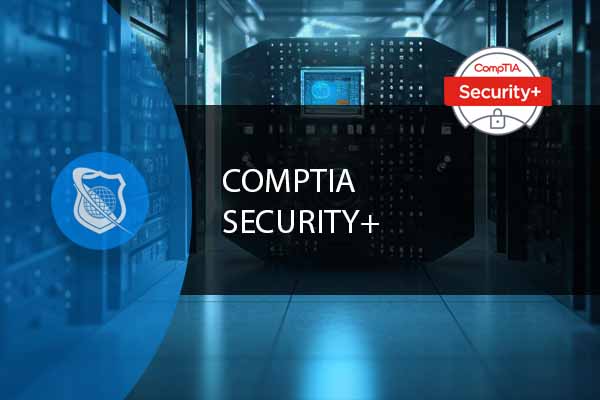Setting the Stage for CompTIA Security+ Objectives
In the realm of cybersecurity, a field that is becoming increasingly complex and vital, understanding threats, attacks, and vulnerabilities is not just beneficial—it’s essential. This blog post serves as the second installment in a 7-part series that aims to dissect and elaborate on the CompTIA Security+ objectives. Today, our focus is on the first domain, aptly titled “1.0 Threats, Attacks, and Vulnerabilities.” Accounting for 21% of the CompTIA Security+ exam, this domain is a cornerstone for anyone aspiring to make a mark in the cybersecurity field. Whether you’re a seasoned professional or a newcomer, mastering this domain is key to acing the exam and, more importantly, enhancing your practical cybersecurity skills.
| Domain | Percentage of Examination | Key Subtopics |
|---|---|---|
| 1.0 Threats, Attacks and Vulnerabilities | 21% | Malware Types, Types of Attacks, Threat Actors |
| 2.0 Technologies and Tools | 22% | Network Components, Software Tools, Troubleshooting |
| 3.0 Architecture and Design | 15% | Frameworks, Network Architecture, Systems Design |
| 4.0 Identity and Access Management | 16% | AAA, Multifactor Authentication, Account Management |
| 5.0 Risk Management | 14% | Policies, Business Impact, Risk Assessment |
| 6.0 Cryptography and PKI | 12% | Symmetric Algorithms, Asymmetric Algorithms, Hashing |
Secure Your Networks and Prevent Password Breaches
Our robust CompTIA Sec+ course is the perfect resouce to ensure your company’s most valuable assets are safe. Up your security skills with this comprehensive course at an exceptional price.
The Importance of Understanding Threats, Attacks, and Vulnerabilities in Line with CompTIA Security+ Objectives
Before we delve into the technical aspects and nitty-gritty details, it’s crucial to address why this particular domain is so critical within the CompTIA Security+ objectives. We live in a digital age where cyber threats are not just evolving but are doing so at an unprecedented rate. From ransomware attacks crippling global corporations to phishing scams targeting individuals, the cyber landscape is fraught with hazards.
Understanding the different types of threats, the mechanisms behind various attacks, and the potential vulnerabilities that could be exploited is not just an academic exercise. It’s a practical necessity that can spell the difference between a secure network and a compromised one. This domain, therefore, serves a dual purpose: it equips you with the knowledge and skills to identify, analyze, and mitigate risks effectively, and it prepares you for real-world challenges that go beyond the scope of the CompTIA Security+ exam.
By mastering the concepts in this domain, you’re not just preparing to pass an exam; you’re gearing up to become a cybersecurity sentinel, capable of guarding digital fortresses and mitigating risks in real-world scenarios.
Types of Threats: More Than Just Malware in the Context of CompTIA Security+ Objectives
When it comes to cybersecurity, threats come in various forms and sizes. Understanding these threats is a key component of the CompTIA Security+ objectives, particularly in the domain of “1.0 Threats, Attacks, and Vulnerabilities.” Let’s delve deeper into the different types of threats you need to be aware of.
Malware: The Common Culprit in Cybersecurity Threats
When the term “cyber threats” is mentioned, malware often springs to mind as the most common culprit. Malware, short for malicious software, is an umbrella term that encompasses various types of harmful programs, including viruses, worms, and Trojans. Each of these has unique characteristics and behaviors that can compromise the security of a system or network. Understanding these malware types is not just a requirement for the CompTIA Security+ exam but also the first step in effective real-world cybersecurity. Knowing how malware operates allows you to implement countermeasures that can detect, prevent, or remove these malicious programs.
Social Engineering: The Human Factor in Cyber Threats
Another significant threat that aligns with the CompTIA Security+ objectives is social engineering. Unlike malware, which exploits software vulnerabilities, social engineering attacks target the most unpredictable element in any security setup: the human factor. Tactics such as phishing, pretexting, and tailgating exploit human psychology to gain unauthorized access to systems or data. Being aware of these tactics is crucial for both passing the CompTIA Security+ exam and for safeguarding against these types of attacks in a real-world setting. Training and awareness programs can go a long way in mitigating the risks associated with social engineering.
Advanced Persistent Threats (APTs): The Silent and Deadly Cyber Threats
Advanced Persistent Threats, or APTs, are another category of threats that are covered under the CompTIA Security+ objectives. These are long-term, highly sophisticated attacks that are often aimed at specific organizations, government agencies, or individuals [1]. Unlike other types of threats that seek immediate gains, APTs are more insidious. They often go unnoticed and can exfiltrate data or compromise systems over an extended period. Understanding APTs is essential for not just the CompTIA Security+ exam but also for recognizing and defending against these stealthy threats in your professional career.
Secure Your Networks and Prevent Password Breaches
Our robust CompTIA Sec+ course is the perfect resouce to ensure your company’s most valuable assets are safe. Up your security skills with this comprehensive course at an exceptional price.
Tools and Techniques: The Arsenal for Cybersecurity in Line with CompTIA Security+ Objectives
In the ever-evolving landscape of cybersecurity, having the right tools and techniques at your disposal is crucial. This is especially true when preparing for the CompTIA Security+ exam, where understanding the various tools used for ensuring cybersecurity is a key part of the objectives. Let’s explore some of the essential tools and techniques that every cybersecurity professional should be familiar with.
Firewalls: The First Line of Defense in Cybersecurity
Firewalls serve as the first line of defense in any cybersecurity strategy, a point emphasized in the CompTIA Security+ objectives. These tools act as a barrier between your network and the outside world, filtering incoming and outgoing traffic based on predetermined security rules. Firewalls can be hardware-based, software-based, or a combination of both, and they play a pivotal role in preventing unauthorized access to network resources. Understanding how to configure and manage firewalls effectively is not just essential for the CompTIA Security+ exam but also for maintaining robust network security in real-world scenarios.
Intrusion Detection Systems (IDS): The Watchdogs of Network Security
Intrusion Detection Systems, commonly known as IDS, are another critical component in the cybersecurity toolkit. These systems continuously monitor network traffic, looking for suspicious activities or anomalies that could indicate a security breach. When such activities are detected, IDSs alert administrators, allowing for immediate action. This makes IDS an invaluable tool for identifying unauthorized access, data breaches, and other security incidents. Mastery of IDS is not only beneficial for meeting CompTIA Security+ objectives but also for ensuring the ongoing security of any network you may be responsible for in your career.
Antivirus Software: Not Just for PCs, but an Integral Part of Cybersecurity
Antivirus software has evolved far beyond its original purpose of scanning PCs for known viruses. Modern antivirus solutions are comprehensive security suites that offer real-time protection against a wide range of threats, including malware, phishing attacks, and even ransomware. These solutions often integrate with other security tools, providing a multi-layered approach to cybersecurity. Understanding the capabilities and limitations of antivirus software is crucial for both the CompTIA Security+ exam and real-world application. In today’s threat landscape, antivirus software is not just an optional add-on but an integral part of a holistic cybersecurity strategy.
Identifying and Mitigating Vulnerabilities: A Core Aspect of CompTIA Security+ Objectives
One of the key elements in cybersecurity, and a significant part of the CompTIA Security+ objectives, is the identification and mitigation of vulnerabilities. Vulnerabilities are the weak spots in your security armor, and knowing how to find and fix them is crucial. Let’s explore some of the tools and techniques that are essential for this process.
Vulnerability Scanners: The Proactive Approach to Cybersecurity
Vulnerability scanners are automated tools designed to scan systems for known vulnerabilities. These tools can scan an entire network or focus on specific devices, applications, or even code. Regular scans are essential for maintaining a secure environment, as they help you identify weak points before they can be exploited. Understanding how to use vulnerability scanners effectively is not only a requirement for the CompTIA Security+ exam but also a best practice in real-world cybersecurity management.
Patch Management: An Ongoing Necessity in Cybersecurity
Software vulnerabilities are often the low-hanging fruit for attackers. These vulnerabilities can be in the operating system, third-party applications, or even in custom-developed software. Patch management involves keeping your software up-to-date with the latest security patches to minimize risks. Effective patch management is crucial for both meeting CompTIA Security+ objectives and for maintaining a secure operational environment. It’s not just about applying patches but also about managing them in a way that minimizes disruptions to operations.
Secure Your Networks and Prevent Password Breaches
Our robust CompTIA Sec+ course is the perfect resouce to ensure your company’s most valuable assets are safe. Up your security skills with this comprehensive course at an exceptional price.
Risk Assessments: The Roadmap for Security Measures
Conducting regular risk assessments is another critical aspect of cybersecurity, emphasized in the CompTIA Security+ objectives. Risk assessments help you identify vulnerabilities and threats systematically, allowing for the implementation of appropriate security measures. These assessments can range from simple checklists to complex analyses involving threat modeling and simulations. The goal is to understand the potential impact of various threats and to prioritize security efforts accordingly.
Real-world Applications: Beyond the CompTIA Security+ Objectives
Mastering the domain of “1.0 Threats, Attacks, and Vulnerabilities” is not just about passing the CompTIA Security+ exam; it has real-world applications that are invaluable. Whether you’re a network administrator responsible for maintaining a secure network, a security analyst tasked with monitoring and responding to incidents, or an IT manager overseeing a team, the knowledge and skills gained from this domain are crucial. You’ll find that these skills are not just theoretical but practical tools that can be applied to safeguard digital assets, protect customer data, and maintain the overall integrity of any organization’s cybersecurity posture.
Conclusion: Mastering Threats, Attacks, and Vulnerabilities
In the ever-changing landscape of cybersecurity, staying ahead of threats, attacks, and vulnerabilities is not just an option; it’s a necessity. This blog has aimed to provide a comprehensive understanding of the first domain in the CompTIA Security+ objectives. With this knowledge, you’re one step closer to not only acing your CompTIA Security+ exam but also becoming a cybersecurity expert.
Header Title : CompTIA Security+ Exam Objectives: Threats, Attacks, and Vulnerabilities FAQ
What are the key CompTIA Security+ objectives related to threats, attacks, and vulnerabilities?
The CompTIA Security+ certification exam’s objectives for threats, attacks, and vulnerabilities focus on equipping candidates with the knowledge to identify and address various cybersecurity threats. This includes understanding the nature of different types of cyberattacks (like phishing, ransomware, and DDoS attacks), the vulnerabilities that attackers exploit, and the strategies for mitigating these risks. The objectives also cover threat analysis, the importance of security controls, and incident response techniques.
How important is understanding vulnerabilities for the CompTIA Security+ exam?
Understanding vulnerabilities is crucial for the CompTIA Security+ exam. This knowledge forms the foundation for cybersecurity practices, as vulnerabilities are the weaknesses that threats exploit to launch attacks. The objectives emphasize identifying, analyzing, and mitigating vulnerabilities to protect against threats and reduce the impact of attacks, which is essential for maintaining organizational security.
Can you explain how threat intelligence is applied in CompTIA Security+ objectives?
Threat intelligence in the context of CompTIA Security+ objectives involves collecting, analyzing, and applying information about emerging threats and vulnerabilities. This process helps candidates understand the current cyber threat landscape, predict potential attacks, and develop strategies for prevention and response. The objectives highlight the importance of utilizing threat intelligence to enhance security measures, make informed decisions, and improve the overall security posture of an organization.
What role do incident response procedures play in CompTIA Security+ objectives on threats, attacks, and vulnerabilities?
Incident response procedures are a critical component of the CompTIA Security+ objectives concerning threats, attacks, and vulnerabilities. These procedures provide a structured approach for handling security incidents, minimizing damage, and recovering from attacks. The objectives cover the steps involved in incident response, including preparation, detection, containment, eradication, recovery, and lessons learned, emphasizing the importance of a well-planned response to maintain operational continuity and protect sensitive information.
How does the CompTIA Security+ exam address the evolution of cyber threats and vulnerabilities?
The CompTIA Security+ exam addresses the evolution of cyber threats and vulnerabilities by constantly updating its objectives to reflect the latest trends and techniques used by attackers. This includes covering new types of malware, emerging attack vectors, and the latest cybersecurity technologies and practices for defense. The objectives ensure that candidates are prepared to tackle current and future cybersecurity challenges, making them well-equipped to contribute to the security efforts of their organizations.
Secure Your Networks and Prevent Password Breaches
Our robust CompTIA Sec+ course is the perfect resouce to ensure your company’s most valuable assets are safe. Up your security skills with this comprehensive course at an exceptional price.
Explore Our Comprehensive 6-Part Series on CompTIA Network+ Exam Domains
Dive deep into the world of networking with our extensive 6-part blog series designed to be your ultimate guide for the CompTIA A+ Exam. Each blog focuses on a specific domain, providing expert insights, study tips, and real-world applications to help you master the subject and ace the exam. Click on the titles below to explore each domain in detail.
CompTIA Security+ Certification: Your Ultimate Guide (1 of 7 Part Series)
CompTIA Security+ Objectives : Threats, Attacks and Vulnerabilities (2 of 7 Part Series)
CompTIA Security: Technologies and Tools (3 of 7 Part Series)
Security CompTIA : Architecture and Design (4 of 7 Part Series)
CompTIA Security +: Identity and Access Management (5 of 7 Part Series)
CompTIA Security Plus : Risk Management (6 of 7 Part Series)
Security CompTIA + : Cryptography and PKI (7 of 7 Part Series)

























